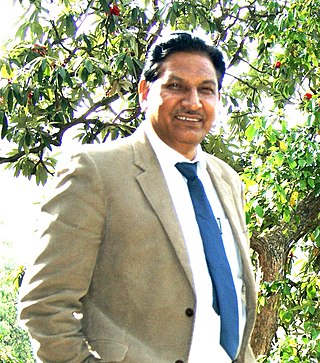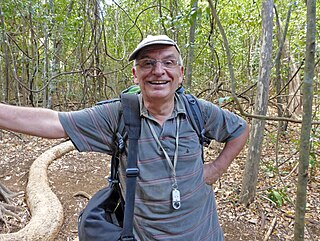David Leslie Hawksworth is a British mycologist and lichenologist currently with a professorship in the Universidad Complutense de Madrid in Madrid, Spain and also a Scientific Associate of The Natural History Museum in London. In 2002, he was honoured with an Acharius Medal by the International Association for Lichenology. He married Patricia Wiltshire, a leading forensic ecologist and palynologist in 2009. As of 2022, he is the Editor-in-Chief of the journals IMA Fungus and Biodiversity and Conservation.
Hildur Krog was a Norwegian botanist.
André Aptroot is a Dutch mycologist and lichenologist.

Dalip Kumar Upreti is an Indian lichenologist. He served as Director and Chief Scientist at CSIR-National Botanical Research Institute, Lucknow during 1988 to 2017. Also he served as Head of Lichenology and herbarium division. Presently he is serving as CSIR-Emeritus Scientist in the same division.
Rolf Santesson (1916–2013) was a Swedish lichenologist and university lecturer. He was awarded the Acharius Medal in 1992 for his lifetime contributions to lichenology.
Peter Wilfred James (1930–2014) was an English botanist and lichenologist. He was a pioneer in the study of lichens as environmental indicators, especially of atmospheric pollution.

David John Galloway, FRSNZ was a biochemist, botanist, and lichenologist.
Thomas Hawkes Nash III is an American lichenologist. His research is about the biology and ecology of lichens, and the effects of air pollution on plants and lichens. He is known as an authority on the family Parmeliaceae. During his long career at the Arizona State University, he helped develop the lichen herbarium into a world-class collection with over 100,000 specimens representing more than 5000 species. In 2010, the year of his retirement, he was awarded the Acharius Medal for lifetime achievements in lichenology, and the following year had a Festschrift published in his honor.
John Alan (Jack) Elix emeritus professor in chemistry at the Australian National University, is an organic chemist who has contributed in many fields: lichenology, lichen chemotaxonomy, plant physiology and biodiversity and natural product chemistry. He has authored 2282 species names, and 67 genera in the field of mycology.
Per Magnus Jørgensen is a Norwegian botanist and lichenologist, and Professor Emeritus of systematic botany at the University of Bergen. He is known for his work on the lichen families Pannariaceae and Collemataceae. Jørgensen was awarded the Acharius Medal in 2021 for his lifetime contributions to lichenology.
Brian John Coppins is a botanist and lichenologist, considered a world authority on crustose lichens and a leading expert on the genus Micarea.
Antonín (Toni) Vězda was a Czech lichenologist. After completing a university education that was postponed by World War II, Vězda taught botany at the Czech University of Life Sciences. In 1958, he was dismissed from his university position as a result of the restrictions placed on academic freedoms by the communist regime in power. He eventually was hired as a lichen researcher by the Czechoslovak Academy of Sciences, who allowed him to work from his apartment, which served also as an office and herbarium.
Peter Crittenden is a British lichenologist. His research largely concerns the ecophysiology of lichens. Crittenden is known for using new techniques to study lichens, such as the use of 3D printing and X-ray computed tomography to study lichen structure and development. He served as the senior editor of the scientific journal The Lichenologist from the years 2000–2016; and still serves on the editorial board for the journal Fungal Ecology. Crittenden was the president of the British Lichen Society in 1998–1999, and president of the International Association for Lichenology from 2008 to 2012. He was awarded the Acharius Medal at the 10th International Mycological Congress in Bangkok in 2014, for his lifetime achievements in lichenology.

Emmanuël Sérusiaux is a Belgian lichenologist. His career, spanning more than four decades, has combined both lichenology research and political aspects of nature conservation. He spent several periods working as a researcher at the National Fund for Scientific Research and the University of Liège, the latter in which he accepted a faculty position as professor and head of the Plant Taxonomy and Conservation Biology unit. Sérusiaux also served for three non-consecutive appointments as Deputy Chief of Staff in the Government of Wallonia. He retired from both his academic and political positions in 2019.

The following outline provides an overview of and topical guide to lichens.
The British Lichen Society (BLS) was founded in 1958 with the objective of promoting the study and conservation of lichen. Although the society was founded in London, UK, it is also of relevance to lichens worldwide. It has been a registered charity since 1964.
Mark Richard David Seaward is a British ecologist and lichenologist. He was awarded the Acharius Medal in 2006 for lifetime contributions to lichenology.
Alexandra "Sandy" M. Coppins is a Scottish lichenologist. She was president of the British Lichen Society from 2002 to 2004.
Thomas Douglas (Dougal) Victor Swinscow (1917–1992) was the founder of the British Lichen Society and the scientific journal The Lichenologist. He was also a member of the editorial team of the British Medical Journal and deputy editor from 1964 until 1977.

Robert Lücking is a German lichenologist. He earned his master's and PhD from the University of Ulm, focusing on the taxonomy, ecology, and biodiversity of foliicolous lichens. He has received numerous awards for his work, including the Mason E. Hale Award for his doctoral thesis, the Augustin Pyramus de Candolle prize for his monograph, and the Tuckerman Award twice for his publications in the scientific journal The Bryologist. Since 2015, he has been serving as the curator of lichens, fungi, and bryophytes at the Berlin Botanical Garden and Botanical Museum. Several lichen species and a genus have been named in his honour.




